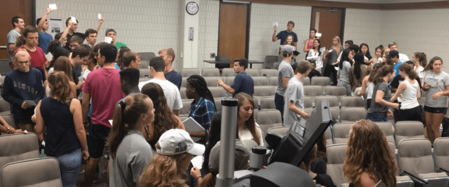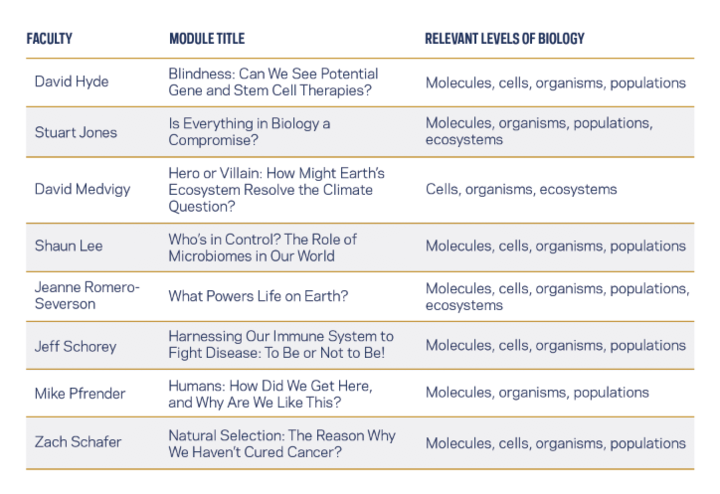
For many, the phrase “Introductory Course” conjures up the image of a large classroom, dominated by lectures and intensive exams. Notably however, introductory courses are critical for both providing a foundation for subsequent courses, and planting the initial seed of excitement for one’s discipline. Introductory courses also link the educational past and future of students, and therefore, previous knowledge and experiences have to be considered while providing foundational content. But students may differ in both their knowledge and expectations for such courses. Add serving many hundreds of students each year, with a diversity of majors and career pathways, and you have the complex challenge of teaching Introductory Biology!
Three years ago, Biological Sciences faculty met to address this challenge by designing and implementing a new Introductory Biology course sequence. The overarching goal was to develop a set of courses that would incorporate innovative pedagogies and student-centered learning while actively engaging students in the discipline of biology.
Why was a new introductory biology course needed?
The impetus for initial discussions came at two levels. Nationally, there had been many calls for changes in the teaching of introductory biology at college and universities. This culminated with ‘Vision and Change in Biology Education: A Call to Action’ published by the American Association for the Advancement of Science in 2011. Vision and Change argued for a more process-driven approach to teaching biology, with less focus on rote memorization of facts and more emphasis on major concepts and competencies required for biological literacy. At the same time, faculty in Biological Sciences were discussing issues of student retention, engagement, and performance in introductory courses. With a charge from Crislyn D’Souza-Schorey, the department chair, a group of faculty began the design of an innovative introductory biology course that would meet the needs of students by harnessing the strengths of faculty.
What framework was established?
The team began with the goal of imagining the ideal first exposure to college biology. Faculty used design thinking, especially the "building-up" of ideas with few limits on discussion, and soliciting input from a broad representation of faculty. The team established “three pillars” or objectives of the introductory biology sequence:
- To help students think like a biologist
- To build a students foundational knowledge about biology
- To develop enthusiasm in students for biology.
The three pillars provided the framework for more specific learning goals, such as being able to contribute to the creation of biological knowledge and applying quantitative techniques to the investigation of biological systems.
Undergirding the broader framework was a commitment to inclusive excellence and development of intellectual virtues. Inclusive excellence recognizes that academic success depends, at least in part, on prior educational experiences, and that these experiences can differ dramatically among students in one classroom. Thus, inclusive classrooms and courses are thoughtfully designed so that all students can fulfill their potential. Intellectual virtues are thinking dispositions that enable the pursuit of truth, knowledge, and understanding, and establish essential traits for successful learning and research. This meant designing the new courses so that they promoted both understanding of biological concepts as well as thinking dispositions, such as curiosity and courage to generate and ask questions, along with the autonomy and open-mindedness when evaluating responses to those questions.
After several iterations and discussions with the faculty, the design group proposed a sequence of two lectures courses, Biology I: Big Questions and Biology II: Molecules to Ecosystems, and two laboratory courses, Biological Investigations and Research Experience in Biology. The structure and content of these courses would reflect not only the collective experience of faculty but also the best available research in science education.

So what is the new introductory biology sequence?
The sequence begins with Big Questions (BQ), a modular course designed to introduce timely, important, and engaging questions that biologists grapple with in their research. The goal is to spark students’ interest in the discipline, and to give them a chance to practice thinking like a professional biologist. Students selected two of eight modules offered by Biological Sciences faculty in their area of research expertise. With careful planning, all 532 students were able to participate in their top ranked module. Modules in Fall 2018 investigated questions in biology from the use of gene and stem cell therapy, to human evolution, and climate change (see table below). Although starting with asking big questions instead of traditional “content” may seem counterintuitive, this approach provides an intellectual scaffold onto which students can build knowledge and is consistent with the science of learning. Students need a mental framework in which to place new information; without a preexisting set of experiences that generate this framework, information retention is very low.
Equipped with a set of tangible and cutting edge examples from biology, the second course in the sequence, Molecules to Ecosystems (M2E), addresses the details of how biology works, from the function of basic molecules to the dynamics of complex ecosystems. The course is structured into five units around the major themes in biology identified in Vision and Change, including the evolution of organisms, flow of biological information, relationships between structure and function, metabolism and the transformation of matter and energy, and homeostasis in biological systems. (See table: Molecules To Ecosystem Units). This approach allows students to acquire the foundational knowledge needed for future coursework along with developing the thinking dispositions of a biologist.

In the laboratory courses, students gain a practical experience of “doing biology”. This begins with Biological Investigations, structured around four projects that introduce critical techniques and skills needed to undertake biological science. In the second semester, for Research Experience in Biology students choose a semester long research project which provides an opportunity to engage in active research at Notre Dame. Subjects include environmental change, vector biology, tuberculosis, and cancer biology. The laboratories provide a critical opportunity for students to apply the concepts and principles from the lecture courses, while experiencing the challenges and rewards of genuine research.
Throughout the course sequence there are four commonalities. First, the student to instructor ratio is kept relatively small with lecture section sizes of between 70-80 students to reduce the anonymity of larger class sizes while facilitating active learning. Second, course content goes beyond textbook coverage. Instead of following a predictable sequence of textbook chapters, students are invited into the world of biology by exploring relevant questions, debates, and primary literature. Furthermore, the information is contextualized; in BQ, by the research of faculty and in M2E, by Vision and Change concepts. Third, significant thought and effort are devoted to the design of assignments and assessments used in courses. For example, in BQ a variety of novel assignments, such as the production of a Public Service Announcement video, are used to generate student interest; in M2E, a diversity of assessments reflected inclusive excellence and reduced the impact of high-stakes testing. Fourth, the courses provided a wealth of online and in-person resources to help students to succeed regardless of their prior knowledge, experiences, and capabilities. This included integration of graduate and undergraduate teaching assistants in both lecture and laboratory courses, providing an essential intellectual bridge between students and instructors.
What were student and faculty experiences?
From a faculty perspective, the new courses required a significant amount of resources and effort. This came as no surprise as new and innovative courses are never undertaken lightly, especially those that require the coordination of 20 faculty involved in lecture and laboratory courses. However, the consensus from instructors was that the effort and resources were worth the investment from several perspectives. Students were engaged in course content and this was then reflected in the day-to-day attendance in lecture, retention in the course and the major, and student performance in assignments and assessments. Moreover, student comments suggest that while improvements could be made, the student experience of introductory biology has been transformed by the new courses.
What are the next steps?
Most immediately, a formal assessment of course content and outcomes by the Institute for Educational Initiatives is underway and will be completed by August 2019. Faculty have also reflected upon course structure and content, and how that translated into student experience, and will use those reflections, to modify courses for the upcoming academic year. For example, M2E is considering better alignment of exam content with learning objectives while BQ is considering how assessment of individual assignments contributes to the overall grade. One important longer term goal is to share the results of these endeavors regionally and nationally. Presentations and manuscripts are being considered for national conferences and education journals. Everyone involved in the development and implementation recognizes that, as with any new course, repeated implementation and evaluation will help address any remaining issues. Nonetheless, tremendous progress has been made in offering a suite of innovative introductory biology courses.
Conclusion
Our development of a new introductory biology sequence has been successful in addressing the initial charge. We have met the initial goals of developing and implementing innovative introductory courses. There is recognizable need to build on this initial success and sustain the course into the future. With continued support from the department, college, and university, instructors are optimistic about the future of the new Introductory Biology sequence, and its potential promise for both students and faculty.
